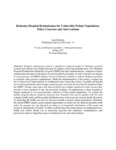Reducing Hospital Readmissions for Vulnerable Patient Populations: Policy Concerns and Interventions

View/
Author
Roberts, Jacob Stuart
Subject
Washington and Lee University, Shepherd Poverty Program
Medicare -- Cost control
Hospitals -- Prospective payment
Hospitals -- Admission and discharge
Health care reform -- Moral and ethical aspects
Metadata
Show full item recordDescription
Jacob Stuart Roberts is a member of the Class of 2017 of Washington and Lee University. Capstone; [FULL-TEXT FREELY AVAILABLE ONLINE] Hospital readmissions present a significant financial burden to Medicare payment systems and indicate poor health outcomes for patients following hospitalization. The Medicare Hospital Readmissions Reduction Program (HRRP) has been implemented as a measure to reduce readmissions and improve the quality of care provided by hospitals. In order to incentivize changes in care processes, the HRRP employs the use of financial penalties to reduce Medicare payments to hospitals with excessive readmissions. While the implementation of this penalty program has led to macro-level improvements in readmission rates across the country, hospitals serving the most socioeconomically disadvantaged patient groups have been the most heavily penalized under the HRRP. Though some argue that these hospitals have higher readmission rates because they provide a lower standard of care, the increased incidence of readmissions at these hospitals is largely explained by the socioeconomic conditions of their patient populations. As a result, the penalty program detracts financial resources from hospitals that care for patients with the most complex health needs, and this penalty distribution may in turn unjustly increase health disparities by restricting the health care services that are available to poorer patient populations. Therefore, the current HRRP penalty system requires adjustments to ensure that the financial penalties made under the program are not allocated according to an inequitable distribution of the social and economic determinants of health. In order to sustain long-term improvements in readmission rates, health care reform should aim at increasing measures that emphasize comprehensive care processes to directly target the causes of readmissions for individual patients. Jacob Roberts